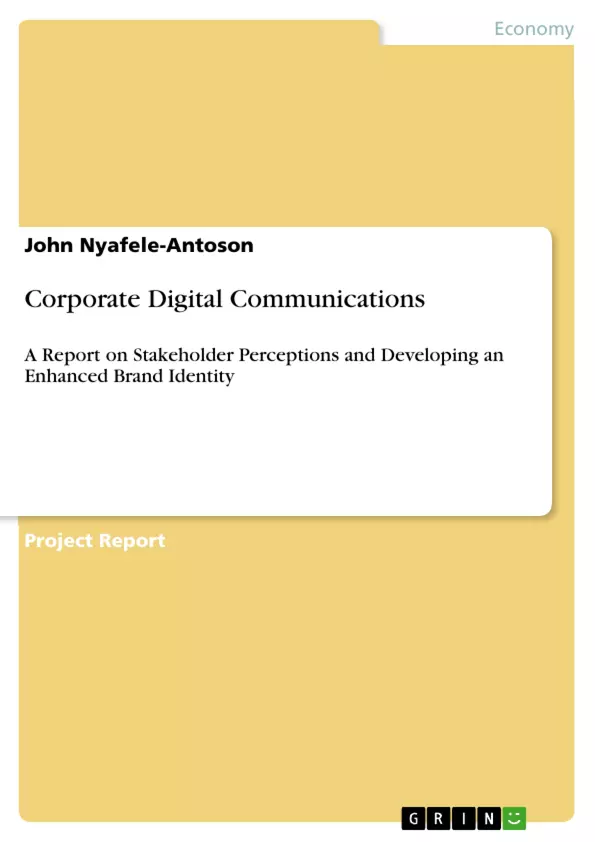This report is in three tasks. The first task provides the organisational summary of the chosen organization (Qatar Airways). Then assesses the current stakeholders’ perceptions of its existing brand identity through stakeholder analysis and mapping and evaluates the ways in which the organisation has developed its brand identity over time and the impact this has had on its reputation. In conducting the stakeholder analysis, eight stakeholder groups were identified and their expectations analyzed. With this done, a thorough assessment was conducted using stakeholder mapping to know their perceptions of the brand identity of Qatar Airways. The assessment revealed that stakeholder perceptions of the brand are generally positive. By evaluating how the brand identity has been developed over time, the context and concepts relating to branding and corporate reputation were first examined and then the impact of the brand identity on the organisation’s reputation was evaluated. This evaluation revealed that Qatar Airways’ brand identity has developed through deliberate brand identity strategies. Generally, the brand identity of the organisation has impacted the company’s reputation positively.
The second task of the report considers the use of digital communications to establish a new brand. It begins by assessing the following as the most relevant digital tools and channels available for establishing and managing brand identity: brand website, social media, mobile phone applications and email. It further evaluates the suitability of two digital channels currently used by Qatar Airways to communicate its brand identity: the organisation’s brand website and its Facebook page. This task then concludes by recommending the following digital communications strategies for establishing an enhanced brand identity: having an increasingly active presence on popular social media platforms; increasing the use of email newsletters; increasing the use of visual elements on social media platforms; providing information consistently and purposefully on the corporate website and developing the corporate website into an online collaboration platform and content hub.
The final task of this report examines how Qatar Airways can develop a new corporate brand identity that better reflects the needs of both the organisation and its stakeholders.
Inhaltsverzeichnis (Table of Contents)
- Stakeholder Analysis
- Development, Evolution and Perception of Corporate Reputation
- Corporate Identity
- Corporate Branding
- Corporate Image
- How Qatar Airways Has Developed Its Brand Identity Overtime
- The Impact of Qatar Airways' Brand Identity on Its Reputation
- The Compatibility of Corporate Strategy, Structure and Culture in Relation to its Positioning and Reputation
- An Assessment of the Current Brand Identity of Qatar Airways
- Recommendations for Developing an Enhanced Brand Identity
- Monitoring and Evaluating the Recommended Strategies
- Digital Tools and Channels for Establishing and Managing Brand Identity
- Digital Channels Currently Used by Qatar Airways to Communicate Brand Identity
- Digital Communications Strategy for Establishing an Enhanced Brand Identity
Zielsetzung und Themenschwerpunkte (Objectives and Key Themes)
This report examines Qatar Airways' brand identity, evaluating its development, impact on reputation, and potential for enhancement. It analyzes stakeholder perceptions, explores digital communication strategies, and recommends steps to refine the brand to better align with both organizational needs and stakeholder expectations.
- Stakeholder analysis and mapping of Qatar Airways' brand identity
- Evaluation of Qatar Airways' brand identity development and its impact on reputation
- Assessment of the current brand identity of Qatar Airways
- Digital communication strategies for enhancing Qatar Airways' brand identity
- Recommendations for developing a new corporate brand identity for Qatar Airways
Zusammenfassung der Kapitel (Chapter Summaries)
- This chapter provides an organizational summary of Qatar Airways, outlining its key characteristics, divisions, and competitive landscape.
- This chapter examines stakeholder perceptions of Qatar Airways' brand identity through stakeholder analysis and mapping. It identifies key stakeholder groups, their expectations, and their overall perception of the brand.
- This chapter delves into the evolution of Qatar Airways' brand identity, exploring the key strategies implemented over time and their impact on the company's reputation. It examines the concepts of corporate identity, branding, and corporate image within the context of Qatar Airways.
- This chapter analyzes the compatibility of Qatar Airways' corporate strategy, structure, and culture with its brand positioning and reputation. It examines the role of the corporate brand in maintaining and developing the organization's positioning.
- This chapter focuses on digital tools and channels for establishing and managing brand identity. It assesses the effectiveness of brand websites, social media platforms, mobile applications, and email as digital communication channels for building brand identity.
- This chapter evaluates the digital channels currently used by Qatar Airways to communicate its brand identity, specifically examining its website and Facebook page.
- This chapter outlines a digital communication strategy for enhancing Qatar Airways' brand identity. It proposes specific strategies, such as increased social media activity, email newsletters, and visual elements on social media, to improve brand visibility and engagement.
Schlüsselwörter (Keywords)
The primary focus of this report is on Qatar Airways' brand identity, encompassing stakeholder analysis, brand development, reputation management, digital communications, and strategies for enhancing the brand's alignment with organizational objectives and stakeholder needs. The report explores various aspects of brand identity, including corporate identity, corporate branding, and corporate image, within the context of the aviation industry.
- Citation du texte
- John Nyafele-Antoson (Auteur), 2020, Corporate Digital Communications, Munich, GRIN Verlag, https://www.grin.com/document/536431



